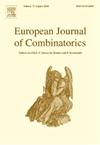之字形欧拉多项式
IF 1
3区 数学
Q1 MATHEMATICS
引用次数: 0
摘要
对于任何有限部分有序集合 P,P-Eulerian 多项式是 P 的线性扩展集合上下降数的生成函数,它与 P 分区理论中出现的 P 的阶多项式密切相关。在这里,我们研究 P-Eulerian 多项式,其中 P 是一个自然标注的之字形正集;我们称这些之字形欧拉多项式为欧拉多项式。Brändén 的一个结果意味着这些多项式是伽马负的,因此它们的系数是对称和单模态的。之字形欧拉多项式和相关的阶多项式曾在各种文献中昙花一现--例如,在研究多面体、图的魔法标注和凯库雷结构时,但似乎还没有对它们进行过系统的研究。我们的技术表明,"之 "字形欧拉多项式也能捕捉到(上下)交替排列集合上 "大回报 "的分布,正如库恩斯和苏利文首次观察到的那样。我们为相关生成函数的改进版本建立了递推关系,这与经典欧拉多项式的递推关系相似。最后,我们将对文献进行梳理,并提出一些开放性问题。本文章由计算机程序翻译,如有差异,请以英文原文为准。
Zig-zag Eulerian polynomials
For any finite partially ordered set , the -Eulerian polynomial is the generating function for the descent number over the set of linear extensions of , and is closely related to the order polynomial of arising in the theory of -partitions. Here we study the -Eulerian polynomial where is a naturally labeled zig-zag poset; we call these zig-zag Eulerian polynomials. A result of Brändén implies that these polynomials are gamma-nonnegative, and hence their coefficients are symmetric and unimodal. The zig-zag Eulerian polynomials and the associated order polynomials have appeared fleetingly in the literature in a wide variety of contexts—e.g., in the study of polytopes, magic labelings of graphs, and Kekulé structures—but they do not appear to have been studied systematically.
In this paper, we use a “relaxed” version of -partitions to both survey and unify results. Our technique shows that the zig-zag Eulerian polynomials also capture the distribution of “big returns” over the set of (up-down) alternating permutations, as first observed by Coons and Sullivant. We develop recurrences for refined versions of the relevant generating functions, which evoke similarities to recurrences for the classical Eulerian polynomials. We conclude with a literature survey and open questions.
求助全文
通过发布文献求助,成功后即可免费获取论文全文。
去求助
来源期刊
CiteScore
2.10
自引率
10.00%
发文量
124
审稿时长
4-8 weeks
期刊介绍:
The European Journal of Combinatorics is a high standard, international, bimonthly journal of pure mathematics, specializing in theories arising from combinatorial problems. The journal is primarily open to papers dealing with mathematical structures within combinatorics and/or establishing direct links between combinatorics and other branches of mathematics and the theories of computing. The journal includes full-length research papers on important topics.

 求助内容:
求助内容: 应助结果提醒方式:
应助结果提醒方式:


